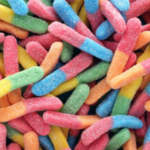
Bio-Heal Serving and Mixing Tricks
What Parents Need to Know
If you’re a parent of a sensitive child, you know what a challenge it can be for them to try new foods.
We’ve talked to hundreds of smart parents who’ve come up with creative ways to serve All- Star Nutrition’s Bio-Heal to their kiddos. Below you will find some tried and true strategies….
Mix the powder into any food or beverage that is room temperature or cooler.
Mix with Smoothies
I’ve tried mixing Bio-Heal with just about every type of food and drink imaginable – and by far, smoothies work the best.
You can grab your free copy of our favorite 12 tasty and healthy smoothie recipes. The smoothie recipes we share make kids feel like they’re having dessert for breakfast.
Mix with Fruit Juice or other Drinks
This is the most popular way that All-Star parents give Bio-Heal. The following juices have worked particularly well:
- Unfiltered Organic Pear Juice
- Orange Juice
- Lemonade
- Citrus/ Tropical Juices (these are very good at concealing any taste)
- Sports Drinks
Click Here to visit the Frother we recommend sold on Amazon to help easily mix Bio-Heal in any drink.
Customer Pro-Tip
“I give Bio -Heal to my child in his favorite drink which is Lemonade. He loves all kinds of flavors, raspberry, mango, blueberry, as long as it has that tart lemonade taste he us down. I mix the powder a little at a time and I use that nifty little milk frother/mixer that’s offered on Amazon”
Martha May
Mix with Soft Foods
Many soft foods mix very well with Bio-Heal. You may want to try some of the following:
- Sorbet/ GFCF Ice Cream
- Yogurt
- Pudding
- Applesauce or mashed banana
- Spaghetti Sauce (after it’s been cooked)
- On top of pasta as kids think it’s parmesan cheese
NOTE: Do not cook or bake with All-Star Nutrition Bio-Heal, as this could affect the potency.
Use a “Special” Cup or Bottle
For some kids, it works well to put their vitamins into a special cup (maybe one with a favorite cartoon character or logo) to help create a consistent and appealing routine that they can count on. A straw can help hide the appearance of anything floating, and a covered cup conceals the appearance of anything out of the ordinary.
Make Popsicles, Ice Cubes, or Gelatine Cups
Some moms have told us they had good success putting Bio-Heal into homemade popsicles that their kids eat with meals. Others have even mixed it into vegetarian gelatin to make small gelatin cups!
Bio-Heal can also be frozen into ice cubes (one dose per cube). The child can either suck the cube directly, or it can be put in a drink.
Add Reinforcement
For some families, using reinforcers (such as a toy or sticker) can help a child be motivated to take their Bio-Heal. ABA sessions can be a great time to teach kids about these reinforcements.

Why Food Dyes are Toxic to Your Health
When you hear the phrase “food dyes,” what comes to mind?
Coloring Easter Eggs?
Creating a special birthday cake?
Making treats fun and eye-catching?
Aggressive behavior and problems sleeping?
Whoa, what’s that last one again?
Although we tend to think of food dyes as changing the color of food only, a closer look at the ingredient list reveals some additives that can have some not-so-pleasant side effects. In fact, extensive research shows that food dyes are associated with the following: hyperactivity, allergies, learning impairment, irritability, aggressiveness, and sleep disturbances. Yikes!
These problems are never fun for anyone, but can be particularly difficult for families with children with autism who already experience significant behavioral challenges.
So what exactly is it in our foods that can be so dangerous? The worst offenders to watch out for on food labels are these artificial colorings: Citrus Red 2, Blue 1 and 2, Red 3 and Number 40, Yellow 5 and 6. Many of these have been banned in different countries, as they’ve been linked to cancer, DNA mutation, and nerve growth. If you see that they’re in certain foods you usually buy, just say no!
Common Culprits:
The sad truth is that these dyes are found in foods that are staples to the American diet, including the following:
- Sodas
- Fruit Cocktail
- Cereal
- Mac & Cheese
- Baked Goods
- Ice Cream
- Candy
- Jello
- Sports Drinks
- Cheese
It can be a rude awakening to learn that some of the foods we have been feeding our kids may contribute in some way to their behavioral challenges, but knowledge is power, and you can’t change what you don’t know.
A Better Way
These food dyes are everywhere, but they don’t have to be part of your family’s life. And while it may seem intimidating to make a complete dietary overhaul, just start small. Check the nutrition facts on foods you purchase. Go for whole, non-processed foods as much as you can. Opt for natural dyes instead of artificial coloring.
Knowing what’s in our foods and cleaning up our diets can do wonders for your family’s health.
Three Concepts of Behavior Patterns
Let’s Recap the Key Concepts of Behavior Patterns
This is not a behavioral disorder – this is extremely important because 99% of the time that’s exactly how it’s treated. Okay, we can say, “How can we eliminate this behavior and train our child to do something else?” The reality is autism is social-relational disorder and every behavior your child exhibits is just a symptom. So trying to address the behaviors doesn’t address the actual autism.
So, take an example. Say your child has an itch and is scratching their arm. You’re like, ‘Hey, stop scratching.’ Okay? Doesn’t work. So you’re like, ‘Hey,’ tie their arm behind their back. Not saying to do that. Doesn’t stop. You just keep repeating over and over. Then you look down and you’re like, ‘Oh. You have a mosquito bite on your arm. That’s easy. Let me just put a little ointment on there.’ Then the itching goes away.
I think that’s the way that most people approach autism. Is they say, ‘Let’s treat the symptoms. Let’s treat the scratching and not find out what the cause is. So my method goes one step deeper, to treat the disorder from the inside out.
Now, kids are not typically born with autism. They’re developing normally. They’re going along and then one day there’s a tipping point where development stops and sometimes even goes backwards. I believe that there’s many things that cause a tipping point. Some people just point to vaccines and just say that’s the cause. I’m not 100% sold out on that. I know that there’s ingredients and things inside of vaccines that cause issues, but I think that’s one of many potential tipping points. Okay?
So, just a quick lesson and common scenario that we see all the time. The most powerful antioxidant in the human body is something called glutathione. Think about it like a Roomba vacuum in your body that’s going around and flushing out free radicals and toxins. Then you go to the doctor, you get a vaccine and they tell you, “Okay, give your child Tylenol for the fever.” Here’s the interesting thing about Tylenol, which the active ingredient is call acetaminophen, is that Tylenol stops your body’s ability to produce glutathione. So it’s kind of like dumping sand all over your house and then taking that battery out of the Roomba. You’re basically creating this toxic pool in the body and brain at the exact same time. You need a deep clean to remove the things from the vaccines, which could very well cause a tipping point.
So, in autism anyway, low levels of glutathione. That’s very typical. Which means that our children have an even tougher time removing toxins from their body. So, we want to be able to eliminate things that add to that dysfunction. So, do yourself a favor and just remove acetaminophen completely and find alternatives. Ibuprofen, it has its downside in terms of the damage it does to the blood, but in terms of damage that is caused with autism. But just take whatever Tylenol you have and throw it out.
Studies have even shown that boys with prenatal acetomorphine exposure are more likely to get clinical symptoms of autism. The more exposure they got, the worse it got. So, it’s not a good thing.
Okay, another key concept here is that gut disfunction is very typical in autism. Since our gut, and we’re going to go into detail next week on what that is, but since our gut makes up 70% of our immune system and some estimates is up to 80, our environment and food toxin can easily push a compromised immune system over the edge.
So, on one hand you have excess toxins in our food and environment and then you have compromised immunity with gut disfunction or glutathione levels and it creates this toxic environment that the body can’t deal with. So what happens is all of the body’s energy goes into self-preservation and not growth, which can cause that tipping point.
So, our goal here, over this entire time is to help heal the gut. Clear that cloud of information and neurotoxicity so that our children can begin to develop going forward again.
